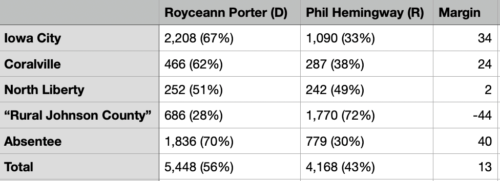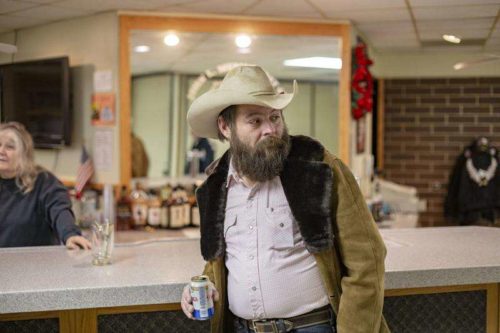Jon Green – former mayor of Lone Tree known to many locals as a Sanders-wing Democrat wearing a cowboy hat – won the Democratic nomination for Johnson County Supervisor. Sanders even endorsed him. And then he defeated Phil Hemingway for the special election victory.
I briefly mentioned Green last month in a post about the perils facing Iowa Democrats in the 2020s. In short, I think the Democrats stand little chance to win statewide the rest of this decade. Why? National demographic changes in voting leave them with a base that’s too small to win. I argued that Iowa Democrats should, in response, re-imagine and rework their base for the future. They should organize new voters and run new sorts of candidates.
Candidates like Jon Green. Or Stacey Walker, or Cathy Glasson. Were I to approach the topic in more detail, I’d suggest Mazahir Salih as a possibility. The point is that Democrats should run candidates who will focus on immigrants, low-wage workers, non-voters, POC voters, and other growing populations in the state of Iowa who don’t currently vote Democratic but whose interests align with the left.
So, how did Jon Green do? Did he help make the case that he could do some of these things statewide?
Jon Green vs. Phil Hemingway
Let’s look at the data and see. First, I’ll show the overall results for the race between Jon Green and Phil Hemingway. I compiled these data into a new table based on the data at the Johnson County Auditor website.

What stands out? Obviously, Green won, and he won big. Green took almost two-thirds of the vote, while Hemingway didn’t even clear one-third. Brian Campbell, an Independent candidate and former Democratic leader, was a non-factor in the race. Furthermore, Green won almost everywhere in the county. While he lost ‘Rural Johnson County’ by 21 points (more on that below), he easily won everywhere else. His campaign has a lot to be proud of here.
I do have a couple of comments to put these data into context. First, Johnson County doesn’t provide a great way for us to draw a distinction between rural parts of the county and other areas. What I call “Rural Johnson County” in the above table is really just a short way of saying “every part of Johnson County that isn’t Iowa City, Coralville, or North Liberty.” So, while it includes just about all of rural Johnson County, it also includes some small towns, unincorporated small communities, and University Heights.
Second, Democrats often win big in Johnson County. For example, Fred Hubbell defeated Kim Reynolds 72-27. And Joe Biden defeated Donald Trump 71-27. Local races tend to be closer than that, and so Green’s win is a bit more impressive than those of Hubbell or Biden. But, overall, Green performed fairly in line with Democratic expectations.
Jon Green vs. Royceann Porter
To get at some of these issues in more depth, I’ll compare Jon Green to Royceann Porter, another Democratic Johnson County Supervisor. In December 2018, Porter beat the very same Phil Hemingway in the very same special election format. In fact, Hemingway runs for office often enough that it’s fair to use him as a marker of “Generic Republican” in Johnson County.
Analogies and comparisons have limits. I think it’s fair to use Porter as a marker for “Generic Democrat,” though that’s strained in some ways. Porter’s politics come from local activism and organized labor. And so, she comes from the liberal to progressive part of the Democratic Party, which is fairly representative of local Democrats. This places her a bit to Green’s political right. She is, of course, black, which is a factor in voter decisions. On the other hand, Porter’s relations with local racial justice activists are mixed. Overall, she has served in office for the past 2+ years as a pretty conventional local Democratic politician. Especially given the makeup of Johnson County.
Data on Green and Porter
Enough with the preamble. Here’s how Porter did against Hemingway.

To get to the point: Green did much better than Porter in every part of the county. But he especially did better than Porter in the rural and unincorporated parts of the county. So, yes, Green lost the rural parts of the county by 21 points. But Porter lost those parts by 44. Green cut Porter’s margin in half.
There’s a more general lesson to draw from this. To win at the state level, Democrats don’t actually need to win rural Iowa. They don’t need to win small towns. They just need to not get blown out by 40-50 points. It’s great for candidates like Fred Hubbell to run up the score among the Democratic base. But often the difference between a win and a loss is just a matter of finding and turning out new voters, along with limiting how badly you lose in heavily Republican areas.
Green showed some evidence he can do this.
Lessons for Statewide
So, does this result prove that Green is ready to run statewide? No, it doesn’t. And I suspect Green would agree with me on this.
For Democrats, winning statewide will still require a lot of work. It’ll require different ways of thinking about how to build a winning electoral coalition. That coalition will involve turning out the Democratic base, yes. But, more important, it’ll involve making connections with immigrants, low-wage workers, (especially younger) POC voters, et al. And, yes, this will also include rural Iowans, especially rural Iowans working lower-wage jobs who don’t currently vote.
Green won a special election in special circumstances (as did Porter). The campaign was barely longer than a month. He simply didn’t have time to do the deeper work involved in building a statewide coalition, because that work will take years. But he showed, at a minimum, that a candidate can run on a good, left-leaning platform while doing well in both the city and the country.
Green improved over Porter the most in rural Johnson County and in Iowa City. If he under performed anywhere, it was the wealthier, moderate suburbs of Coralville and North Liberty. Incidentally, I think those were the areas candidates like Hubbell targeted the most. Green’s win, then, shows potential for an urban and rural working-class coalition, rather than the kind of urban and suburban educated liberal coalition that Iowa Democrats often chase.
In that respect, Green succeeded.

Porter ran in late December, which was even worse timing. And racism is real!
There’s also just the fact that absentee voting – and turnout more generally – are up since the pandemic.
Regarding racism, I don’t see enough in the data to either confirm it or fully rule it out as a factor in how Porter did in 2018. If rural racism were a factor in how she did relative to Green, I’d have expected to see Green do better in rural areas but not in Iowa City. That’s not how it went, though. He did better in both places.
But that’s not enough to totally rule it out.